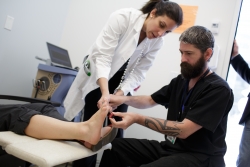Today's post from zedie.wordpress.com (see link below) is a very short one but is none the less important for that. Depending on the infection in your body from whatever cause, you may be prescribed antibiotics. Some of these antibiotics are called fluoroquinolones and are notorious for causing neuropathic symptoms. Very often it will be difficult to spot the name fluoroquinolone on the box because the brand and pharmaceutical names will be most prominent. If you already have neuropathy, it may be worth asking your doctor if the antibiotics he/she is prescribing belong to the fluoroquinolone family. If so, it may be worth changing them - there are plenty of alternatives. This short post talks about the American FDA requiring that drug companies place a neuropathy warning on fluoroquinolone packaging. This is of benefit to neuropathy sufferers but also patients who may be at risk of getting neuropathy.

Author Zedie: US Virgin Islands August 16th 2013
The FDA is requiring that the labels of fluoroquinolone antibiotics warn of the drugs’ increased risk for peripheral neuropathy.
The risk has been observed with oral and injectable fluoroquinolones, but not topical agents. Patients could experience peripheral neuropathy any time during their treatment, and it could persist for months or years or be permanent.
Patients should contact their healthcare providers if they develop symptoms consistent with peripheral neuropathy in the arms and legs, including pain, burning, numbness, or weakness; change in sensation to touch, pain, or temperature; or change in the sense of body position.
Patients who develop these symptoms should stop taking the antibiotic and receive alternative therapies unless the benefit of the fluoroquinolone outweighs the risk.
Source: FDA MedWatch safety alert
http://zedie.wordpress.com/2013/08/16/fluoroquinolone-labels-updated-to-reflect-heightened-risk-for-peripheral-neuropathy/


